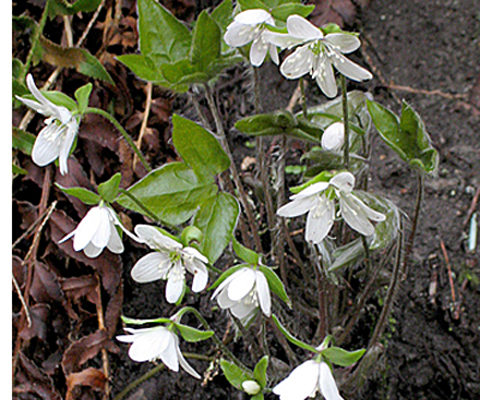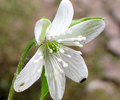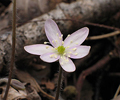It's not a particularly picky plant, although it does need a cold winter to survive and some shade to protect it from the sun's harmful rays. It doesn't hurt to give it some good humus, but this is a plant that will take care of itself. Just let it do its own thing, and you'll be rewarded ten-fold.
Broad and heart-shaped, the leaves get up to 2" in breadth and width. They tend to be dark green and leathery with a smooth surface above, although the undersides are covered with dense hairs.
In autumn, the leaves turn shades of russet and purple to persist through winter. It is critical that the leaves remain during the winter months, as the plant continues to use them as a source of nourishment. 3-lobed, acute or acutish, toothed or lobed again, 2" long and broad leathery. Basal and long-stalked, densely pubescent below and smooth above.
Supposedly a favorite of chipmunks, the fruit is present appears in early summer. Oblong and sharp-pointed, they can get up to 2" long and are covered with silky hairs.
Medicinal uses:
Although the leaves will stop bleeding, they are also extremely irritating to the skin and should not be placed on open wounds. Large doses can produce symptoms of poisoning.
However, not too long ago Hepatica was viewed as the cure-all for most ailments. The Greeks named the plant 'heper', meaning liver (named after the leaf shape), and prescribed it for liver disorders. It was believed that a dose of liverleaf cured all liver diseases or their symptoms: freckles, indigestion, or cowardice.
In North America, Native Americans used the plant as a tea to soothe coughs, irritated throats, and as a wash for sore breasts.
By the 1820's Hepatica had fallen into disuse throughout Europe, but its popularity in America was rapidly growing. In 1859 it was the prime ingredient in "Dr. Roder's Liverwort and Tar Sirup", and was often used as a cure for kidney problems. In the 1883 over 450,000 pounds of dried leaves were harvested for export or domestic use, although its effectiveness was often a reason for debate amongst doctors. For this reason it eventually fell into disuse once again.



